The global peony extract brightening creams market is projected to grow from USD 1,201.3 million in 2025 to approximately USD 3,901.0 million by 2035, recording an absolute increase of USD 2,701.0 million over the forecast period. This translates into a total growth of 224.9%, with the market forecast to expand at a compound annual growth rate (CAGR) of 12.5% between 2025 and 2035. The overall market size is expected to grow by nearly 3.25X during the same period, supported by the rising adoption of natural skincare ingredients and increasing consumer demand for brightening and anti-aging solutions in the global beauty market.
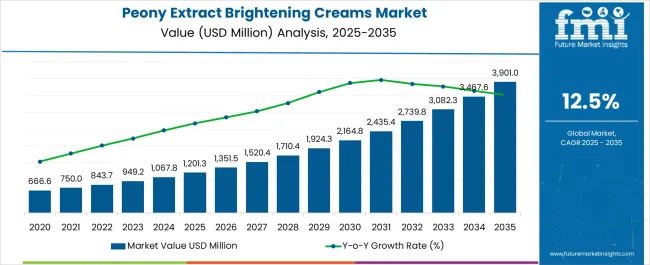
Between 2025 and 2030, the peony extract brightening creams market is projected to expand from USD 1,201.3 million to USD 2,165.1 million, resulting in a value increase of USD 963.8 million, which represents 35.7% of the total forecast growth for the decade. This phase of growth will be shaped by rising consumer awareness of natural and botanical skincare ingredients, increasing demand for K-beauty and Asian skincare products, and growing penetration of premium skincare brands in emerging markets. Beauty brands are expanding their natural ingredient portfolios to address the growing consumer preference for clean beauty and plant-based formulations.
From 2030 to 2035, the market is forecast to grow from USD 2,165.1 million to USD 3,901.0 million, adding another USD 1,737.2 million, which constitutes 64.3% of the overall ten-year expansion. This period is expected to be characterized by expansion of e-commerce channels, integration of advanced skincare technologies with traditional botanical ingredients, and development of personalized beauty solutions. The growing adoption of premium skincare routines and increasing purchasing power in developing markets will drive demand for sophisticated peony extract formulations and specialized product categories.
Between 2020 and 2025, the peony extract brightening creams market experienced robust expansion, driven by increasing consumer interest in Asian beauty traditions, growing awareness of peony's anti-inflammatory and brightening properties, and rising demand for natural alternatives to chemical-based skincare products. The market developed as beauty brands recognized the potential of peony extract in addressing multiple skin concerns including pigmentation, dullness, and signs of aging. Social media influence and beauty blogger endorsements significantly contributed to market awareness and product adoption.
| Metric | Value |
|---|---|
| Estimated Value in (2025E) | USD 1,201.3 million |
| Forecast Value in (2035F) | USD 3,901.0 million |
| Forecast CAGR (2025 to 2035) | 12.5% |
Market expansion is being supported by the increasing consumer shift toward natural and botanical skincare ingredients, driven by growing health consciousness and preference for clean beauty products. Peony extract offers multiple skin benefits including anti-inflammatory properties, antioxidant protection, and natural brightening effects, making it an attractive ingredient for modern skincare formulations. The ingredient's cultural significance in traditional Asian medicine and skincare practices has created strong brand storytelling opportunities that resonate with global consumers.
The growing influence of K-beauty and Asian skincare trends in Western markets is driving demand for products featuring traditional Asian botanical ingredients like peony extract. Social media platforms and beauty influencers are increasing consumer awareness of peony extract benefits, while premium positioning allows brands to capture higher margins. Rising disposable income in emerging markets and increasing consumer willingness to invest in premium skincare products are creating new market opportunities for peony extract brightening creams across diverse geographic regions.
The market is segmented by function, product type, channel, claim, and region. By function, the market is divided into brightening & radiance, pigmentation correction, soothing & calming, and hydration. Based on product type, the market is categorized into creams/lotions, serums, masks, and essence. In terms of channel, the market is segmented into e-commerce, specialty K-beauty retail, pharmacies, and mass retail. By claim, the market is classified into natural/organic, vegan, dermatologist-tested, and clean-label. Regionally, the market is divided into North America, Europe, East Asia, South Asia & Pacific, Latin America, and Middle East & Africa.
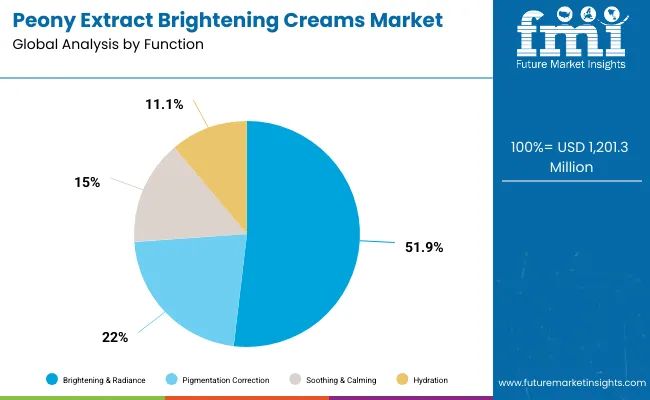
The brightening & radiance function is projected to represent 51.9% of the peony extract brightening creams market in 2025. This leadership is driven by strong consumer demand for solutions that address common skin concerns such as dullness, uneven tone, and lack of vibrancy. Peony extract, rich in natural antioxidants and polyphenols, has been clinically associated with improved clarity and luminosity, making it a trusted natural alternative to harsher chemical brighteners like hydroquinone.
Rising global awareness of “glow-enhancing” skincare, particularly in Asian and Western beauty markets, further supports the segment’s strength. Consumers are increasingly drawn to gentle, plant-based solutions that balance efficacy with skin safety, and peony extract fits this profile perfectly. With growing positioning in anti-pollution and radiance-boosting formulations, the brightening & radiance function is set to remain the most influential driver within this product category.
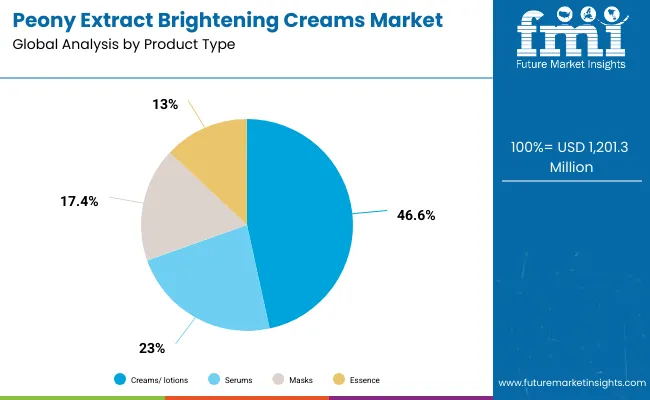
Creams and lotions are expected to account for 46.6% of demand in 2025. This leading share reflects the enduring popularity of traditional skincare formats that combine familiarity, ease of use, and multifunctional benefits. Peony extract incorporated into cream or lotion bases not only delivers brightening effects but also provides essential hydration, nourishment, and skin barrier reinforcement, making them suitable for daily routines across all age groups and skin types.
Their versatility allows for both day and night applications, enhancing adoption rates. The segment also benefits from wide retail availability, spanning mass-market, premium, and dermocosmetic lines. As consumer preferences shift toward natural but effective brightening solutions, creams and lotions remain the most approachable entry point, ensuring strong continuity of demand while accommodating evolving lifestyle needs and diverse price sensitivities.
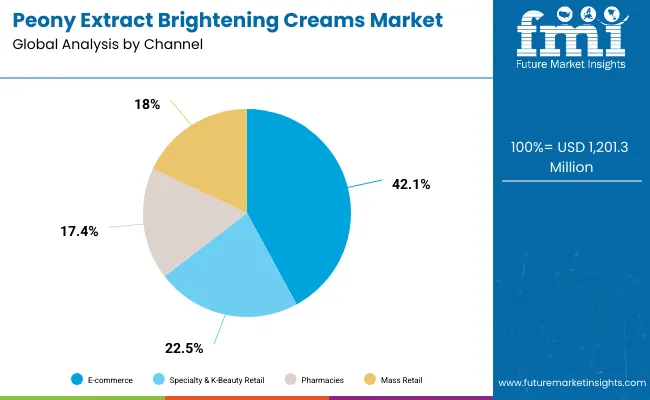
The e-commerce channel is projected to account for 42.1% of the peony extract brightening creams market in 2025. This growth is driven by the increasing consumer preference for online shopping, where digital platforms provide access to niche skincare brands and international formulations not always available in physical stores. E-commerce offers value-added benefits such as detailed ingredient information, consumer reviews, video demonstrations, and educational content on peony extract’s benefits, helping shoppers make informed purchase decisions.
The convenience of home delivery, coupled with frequent promotional campaigns and subscription models, further boosts online sales. Social media beauty communities and influencer-led campaigns amplify product visibility and trust, fueling viral adoption of brightening creams. As digital literacy expands globally, e-commerce will remain a critical driver of distribution, offering brands cost-effective global reach and strong consumer engagement.
The peony extract brightening creams market is advancing rapidly due to increasing consumer interest in natural skincare ingredients and growing influence of Asian beauty traditions. However, the market faces challenges including limited raw material availability, seasonal supply variations, and higher production costs compared to synthetic alternatives. Premium positioning requirements and consumer education needs continue to influence market development and brand strategy approaches.
The growing influence of Korean and Asian beauty trends is driving international adoption of traditional botanical ingredients like peony extract. K-beauty brands are establishing global presence through strategic partnerships and international expansion, introducing Western consumers to Asian skincare philosophies and ingredients. This trend is creating opportunities for both established and emerging brands to incorporate peony extract into their product portfolios while leveraging cultural authenticity and traditional knowledge in marketing strategies.
Modern skincare manufacturers are incorporating advanced extraction methods and nanotechnology to enhance peony extract bioavailability and skin penetration. Development of stabilized peony extract formulations and combination with complementary active ingredients is improving product efficacy and shelf stability. Advanced formulation technologies are enabling creation of innovative product formats and delivery systems that maximize peony extract benefits while meeting diverse consumer preferences.
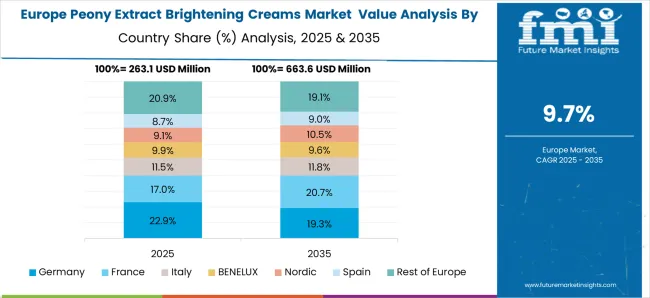
The peony extract brightening creams market in Europe demonstrates sophisticated development across key economies with Germany showing strong interest in botanical brightening solutions and scientific validation of peony's anti-inflammatory and skin-evening properties, driven by consumer preference for gentle yet effective natural ingredients. France represents a significant market through its luxury beauty heritage and appreciation for floral-based cosmetics, with companies like L'Oréal and Fresh pioneering elegant peony-infused formulations that combine French botanical artistry with advanced brightening technologies and premium positioning in luxury skincare segments.
The UK exhibits growing demand for natural brightening alternatives to traditional actives, with increasing consumer awareness of peony's gentle skin-lightening properties and suitability for sensitive skin types. Italy and Spain show expanding interest in botanical brightening solutions, particularly in anti-aging and complexion-evening segments that emphasize natural ingredient efficacy. BENELUX countries contribute through their focus on clean beauty formulations and sustainable sourcing practices, while Eastern Europe and Nordic regions display emerging potential, driven by growing skincare sophistication and increasing access to premium botanical brightening products.
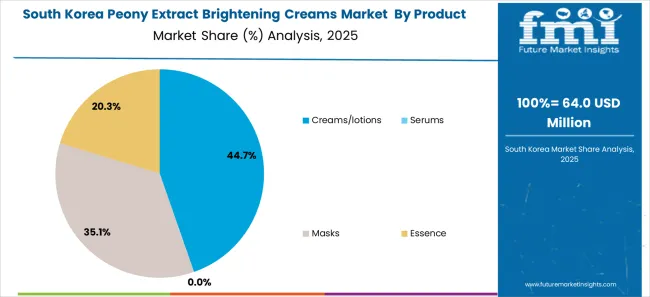
South Korea represents a leading innovation hub for peony extract brightening creams, positioning as a dominant global market with sophisticated consumers who deeply understand botanical ingredients and their traditional skincare applications. Companies like Amorepacific, Sulwhasoo, Innisfree, Etude House, and The Face Shop have established comprehensive presence, developing advanced peony-based formulations that leverage both traditional Korean herbal knowledge and modern cosmetic science to create highly effective brightening solutions.
The market benefits from extensive research capabilities in botanical extraction and fermentation technologies, combined with cultural appreciation for peony's historical use in traditional medicine and beauty practices. Strong domestic cosmetics manufacturing infrastructure supports both local consumption and significant global export opportunities. The integration of peony extract with Korean expertise in gentle yet powerful brightening actives, combined with consumer sophistication in understanding ingredient synergies and long-term skincare benefits, positions the market as both the largest consumer base and primary innovation catalyst for peony extract brightening cream applications worldwide.

| Country | CAGR (2025 to 2035) |
|---|---|
| India | 18.1% |
| China | 16.1% |
| Japan | 13.0% |
| UK | 10.5% |
| Germany | 7.8% |
| USA | 6.7% |
The peony extract brightening creams market is experiencing robust growth globally, with India leading at an 18.1% CAGR through 2035, driven by increasing disposable income, growing beauty consciousness, and rising adoption of premium skincare products. China follows at 16.1%, supported by strong domestic demand, cultural familiarity with peony benefits, and expanding middle-class consumer base. Japan grows at 13.0%, emphasizing quality, innovation, and traditional botanical ingredient expertise. The UK records 10.5%, focusing on natural beauty trends and premium skincare adoption.
Germany shows 7.8% growth, driven by clean beauty preferences and organic product demand. The USA demonstrates steady growth at 6.7%, supported by diverse consumer base and established beauty market infrastructure. Overall, Asian markets emerge as the primary drivers of global peony extract brightening creams market expansion. The report covers an in-depth analysis of 40+ countries; six top-performing markets are highlighted below.
Revenue from peony extract brightening creams in India is projected to exhibit strong growth with a CAGR of 18.1% through 2035, driven by increasing consumer awareness of skincare benefits, rising disposable income, and growing adoption of premium beauty products. The country's expanding middle class and increasing urbanization are creating significant demand for advanced skincare solutions. International beauty brands and domestic manufacturers are establishing comprehensive distribution networks to serve the growing population of beauty-conscious consumers across metropolitan and tier-2 cities.
Revenue from peony extract brightening creams in China is expanding at a CAGR of 16.1%, supported by cultural familiarity with peony benefits in traditional medicine and increasing consumer preference for natural skincare ingredients. The country's established beauty market infrastructure and growing premium skincare adoption are driving demand for high-quality peony extract formulations. Domestic and international brands are leveraging cultural heritage and modern formulation technologies to create products that resonate with Chinese consumers.

Revenue from peony extract brightening creams in Japan is growing at a CAGR of 13.0%, driven by consumer preference for high-quality skincare products and continuous innovation in botanical ingredient applications. The country's advanced beauty industry and sophisticated consumers are creating demand for scientifically-backed peony extract formulations. Japanese beauty brands are leading development of advanced extraction methods and innovative product formats that maximize peony extract effectiveness.
Demand for peony extract brightening creams in the UK is projected to grow at a CAGR of 10.5%, supported by increasing consumer preference for natural and organic beauty products. British consumers are showing strong interest in clean beauty ingredients and sustainable skincare options. The market is characterized by focus on transparency, ingredient sourcing, and environmental responsibility, creating opportunities for brands that can demonstrate authentic natural positioning.
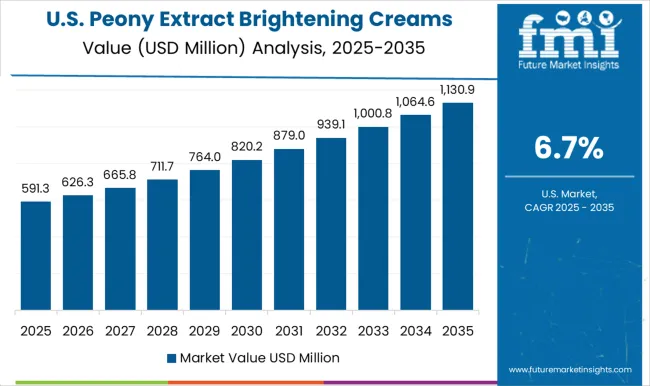
Demand for peony extract brightening creams in the USA is expanding at a CAGR of 6.7%, driven by increasing adoption of Asian beauty trends and growing interest in botanical skincare ingredients. The diverse American beauty market is creating opportunities for both established and emerging brands to introduce peony extract products across different price points and distribution channels. Multi-cultural consumer base and social media influence are supporting market awareness and product adoption.
Demand for peony extract brightening creams in Germany is projected to grow at a CAGR of 7.8%, supported by the country’s strong preference for scientifically validated skincare products and adherence to strict EU cosmetic regulations. German consumers value clinically proven efficacy, ingredient safety, and natural origins, positioning peony extract as an appealing botanical active for premium brightening formulations.
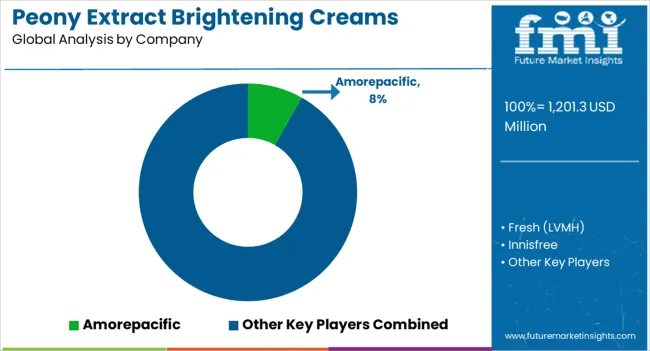
The peony extract brightening creams market is defined by competition among established beauty conglomerates, specialized K-beauty brands, and emerging natural skincare companies. Companies are investing in advanced extraction technologies, clinical research validation, sustainable sourcing practices, and innovative product formulations to deliver effective, premium, and environmentally-responsible peony extract solutions. Strategic partnerships, ingredient innovation, and global expansion are central to strengthening product portfolios and market presence.
Amorepacific holds an 8.2% global market share in 2025, representing the leading position among identified players. The remaining 91.8% market share is distributed among other competitors, indicating a fragmented competitive landscape with opportunities for both established brands and emerging players to capture market share through differentiation and innovation strategies.
Fresh (LVMH) leverages luxury positioning and premium formulation expertise to deliver high-end peony extract skincare solutions. Innisfree emphasizes natural ingredients and Korean beauty heritage in product development and marketing. Etude House focuses on accessible Korean beauty products with innovative formulations. Sulwhasoo positions itself in the luxury segment with traditional Korean ingredients and advanced skincare science.
The Face Shop offers comprehensive skincare solutions with botanical ingredients and competitive pricing. Origins emphasizes natural and organic formulations with environmental responsibility. Herbivore Botanicals focuses on clean beauty and minimalist formulations. Tatcha combines Japanese beauty traditions with luxury positioning and premium ingredients. L'Oréal leverages global distribution capabilities and extensive research and development resources to compete across multiple market segments.
| Items | Values |
|---|---|
| Quantitative Units (2025) | USD 1,201.3 Million |
| Function | Brightening & radiance, Pigmentation correction, Soothing & calming, Hydration |
| Product Type | Creams/lotions, Serums, Masks, Essence |
| Channel | E-commerce, Specialty K-beauty retail, Pharmacies, Mass retail |
| Claim | Natural/organic, Vegan, Dermatologist-tested, Clean-label |
| Regions Covered | North America, Europe, East Asia, South Asia & Pacific, Latin America, Middle East & Africa |
| Countries Covered | United States, Canada, United Kingdom, Germany, France, China, Japan, South Korea, India, Brazil, Australia and 40+ countries |
| Key Companies Profiled | Fresh (LVMH), Innisfree, Etude House, Amorepacific, Sulwhasoo, The Face Shop, Origins, Herbivore Botanicals, Tatcha, and L'Oréal |
| Additional Attributes | Dollar sales by extract concentration and cream format, regional demand trends, competitive landscape, buyer preferences for natural versus synthetic actives, integration with clean-label/whitening positioning, innovations in extraction purity, encapsulation delivery, and sustainable sourcing practices |
Claim:
The global peony extract brightening creams market is estimated to be valued at USD 1,201.3 million in 2025.
The market size for the peony extract brightening creams market is projected to reach USD 3,901.0 million by 2035.
The peony extract brightening creams market is expected to grow at a 12.5% CAGR between 2025 and 2035.
The key product types in peony extract brightening creams market are brightening & radiance , pigmentation correction, soothing & calming and hydration.
In terms of product type, creams/lotions segment to command 46.6% share in the peony extract brightening creams market in 2025.






Full Research Suite comprises of:
Market outlook & trends analysis
Interviews & case studies
Strategic recommendations
Vendor profiles & capabilities analysis
5-year forecasts
8 regions and 60+ country-level data splits
Market segment data splits
12 months of continuous data updates
DELIVERED AS:
PDF EXCEL ONLINE
Peony Extracts for Brightening Market Size and Share Forecast Outlook 2025 to 2035
Extraction Kits Market Analysis - Size, Share, and Forecast Outlook 2025 to 2035
Extracts and Distillates Market
Sage Extract Market Size and Share Forecast Outlook 2025 to 2035
Fume Extractor Market Size and Share Forecast Outlook 2025 to 2035
Meat Extracts Market Size and Share Forecast Outlook 2025 to 2035
Kale Extract Skincare Market Size and Share Forecast Outlook 2025 to 2035
Wine Extract Market Size and Share Forecast Outlook 2025 to 2035
Amla Extract Market Analysis - Size, Share, and Forecast Outlook 2025 to 2035
Dust Extractor Market Growth – Trends & Forecast 2025 to 2035
Data Extraction Software Market
Algae Extracts Market Size and Share Forecast Outlook 2025 to 2035
Juice Extraction Equipment Market Size and Share Forecast Outlook 2025 to 2035
Yucca Extract Market Size and Share Forecast Outlook 2025 to 2035
Maple Extracts Market Size and Share Forecast Outlook 2025 to 2035
Yeast Extract Market Analysis - Size, Share, and Forecast Outlook 2025 to 2035
Yeast Extract Industry Analysis in USA Size, Growth, and Forecast for 2025 to 2035
Basil Extract Market Size, Growth, and Forecast for 2025 to 2035
Understanding Yeast Extract Market Share & Key Players
Anise Extract Market Growth - Flavor Innovations & Applications 2025 to 2035

Thank you!
You will receive an email from our Business Development Manager. Please be sure to check your SPAM/JUNK folder too.
Chat With
MaRIA